A classic Cantonese Beef Chow Fun recipe (Gon Chow Ngau Ho) with tender flavorful beef slices and deliciously chewy rice noodles that can be made with fresh ho fun or dried rice noodles!
Table of Contents
- What is Chinese Beef Chow Fun?
- Ingredients for Beef Chow Fun
- How to Pick and Buy Fresh Ho Fun and Rice Noodles
- How to Make Beef Chow Fun with Dried Rice Noodles
- Tips for Making Beef Chow Fun
- How to Slice Beef Against the Grain
- Preparing the Noodles for the Beef Chow Fun
- Non-Stick Pan or Well Seasoned Wok Works Best
- More Takeout Recipes You May Like
- Recipe Card
What is Chinese Beef Chow Fun?
Cantonese beef chow fun is best known as a dish with chewy rice noodles and flavorful tender beef slices. At its core, it is a simple beef stir-fry with rice noodles.
Even though it is easy to find these noodles at Chinese takeout restaurants, you can easily make this chow fun recipe at home for yourself as well, just make sure you have a good non-stick pan or a well-seasoned wok on hand.
The hardest part about making beef chow fun at home is making the noodles just right so they are not shredded into tiny pieces or mushy.
Fresh ho fun is a tricky ingredient to work with at first, but once you get used to using it, it can be an amazing noodle to use to get dinner on the table in minutes.
I also have a Cantonese Beef Chow Mein recipe, if you are looking for another type of Cantonese noodle takeout dish.
Keep in mind, that that Beef Chow Mein is completely different than Beef Chow Fun. The difference is, that beef chow fun uses fresh ho fun made of rice which has a chewy consistency, and Cantonese chow mein uses thin egg noodles that are fried, which gives it a crispier consistency.
Alternatively, if you are looking for a more saucy beef chow fun with a delicious savory sauce that's poured on top of stir-fried rice noodles, I also have a Saucy Beef Chow Ho Fun with Gravy recipe that might be right up your alley!
Ingredients for Beef Chow Fun
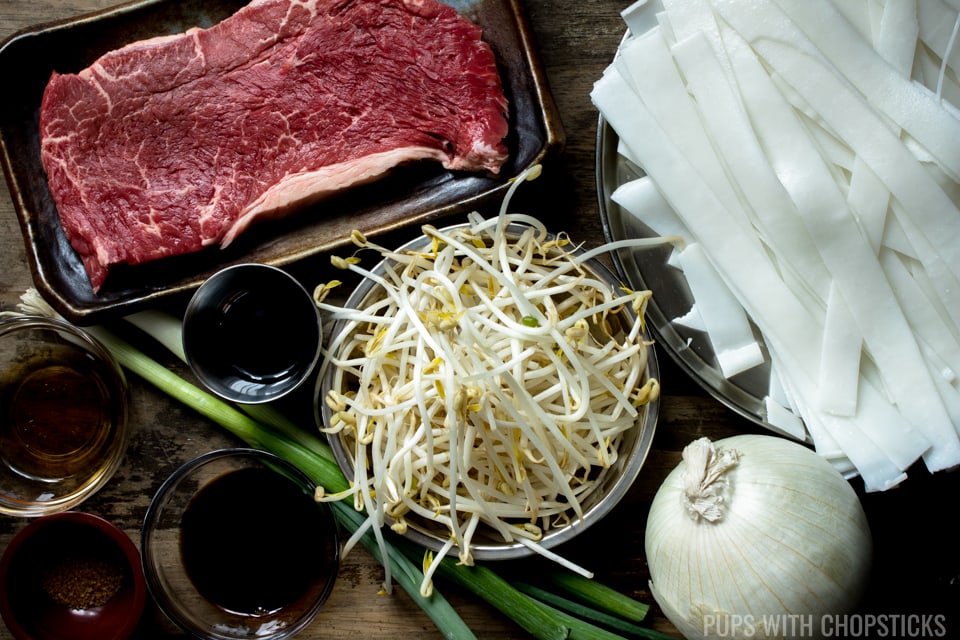
- Beef - For the beef, you can use flank steak or any type of steak as long as you cut the beef into thin slices against the grain.
- Ho Fun Noodles - Beef chow fun uses fresh "sa" ho fun which are fresh rice noodles. I go into detail below on how to find it at an Asian grocery store. You can also use dried flat wide rice noodles as well, but you will need to pre-soak them in hot water ahead of time before you use them. You can also use dried wide rice noodles as well, but make sure they are ½ inch wide. They may be labeled as 'banh pho' on the package.
- Onion - Try to use white onion. White onion is a lot sweeter and has a milder onion flavor so that when you flash fry it quickly and it's still semi-raw it will have a nice sweet crunch without that strong raw onion bite. If you can't find white onions, yellow onions work as well but cook them a bit more to remove the strong onion flavor.
- Soy Sauce - For this beef chow fun recipe, I use both regular soy sauce and dark soy sauce. Dark soy sauce is thicker and gives this noodle dish its signature dark color. If you cannot find it, you can use regular soy sauce or mushroom soy sauce instead but it may not have the dark noodle color.
- Bean Sprouts - Fresh bean sprouts work best for this dish.
- Green Onions - Green onions will give this noodle dish more flavor, as well, and is not just used as a garnish, so I highly recommend using them.
How to Pick and Buy Fresh Ho Fun and Rice Noodles
The key to having long strands of chewy ho fun noodles that can withstand stir-frying is buying the right type of fresh ho fun noodles.
Authentic beef chow fun uses fresh "sa" ho fun (沙河粉), so when you are looking for fresh ho fun at a grocery store, we want to look for the fresh ho fun called "SA" ho fun which is for stir-frying.
Sometimes it is written in English (like in the picture below) and sometimes it isn't and it will just say "ho fun" in English.
I marked the Chinese word "SA" in a circle in the photo so you know what that word would look like in Chinese so you can reference it if you need to. 🙂
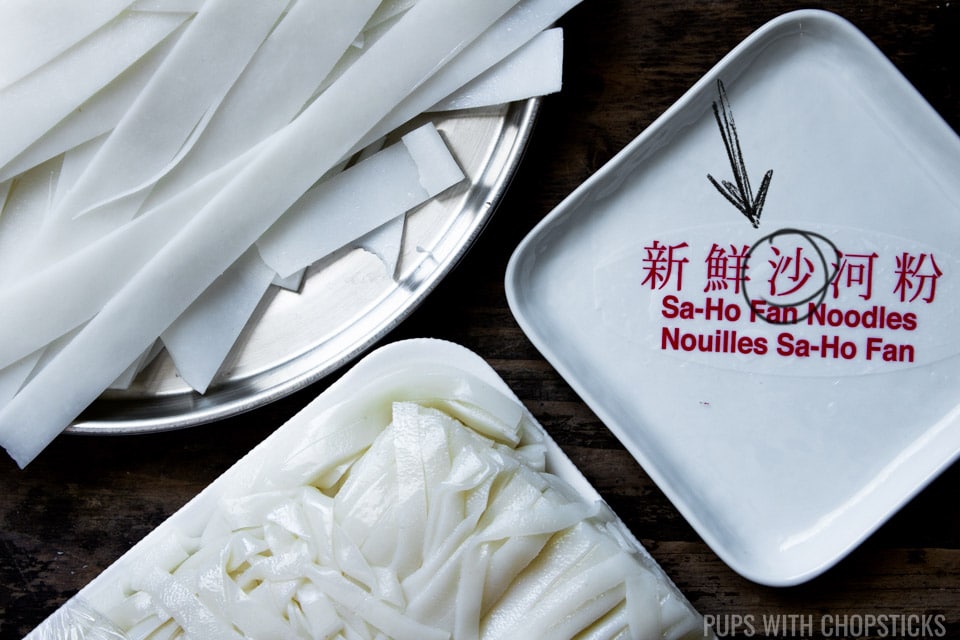
For any kind of stir-frying, try to stay away from the fresh ho funs noodles that are packed into tiny bags (these are usually used for soup noodles and will need to be parboiled), attempting to break up a solid brick of fresh ho fun noodles will usually produce a very shredded and broken up noodle dish.
You want to find these types of fresh noodles in sheets so that you can cut them yourself or pre-cut packaged noodles that are laid out lengthwise.
If you can't find either of them you can use the dried flat wide rice noodles as well, just make sure it is wide and not thin.
I personally find the pre-cut fresh noodles work best - even though separating the noodles is a bit of work.
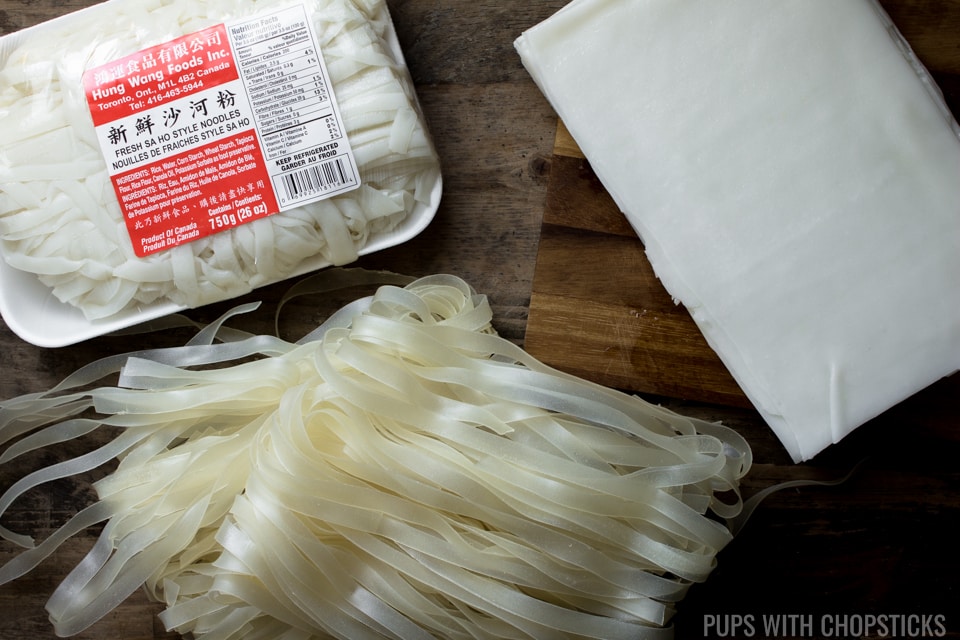
How to Make Beef Chow Fun with Dried Rice Noodles
If you cannot find fresh rice noodles, dried rice noodles are the next best thing.
Use dried wide rice noodles that are ½ inch wide (may also be labeled as 'banh pho').
Soak them in hot water for 6-8 minutes until they are soft and pliable, and drain and set them aside.
When you are ready to cook with them, you will need to add an extra ¼ cup of water to the sauce mix. This will give it a bit more moisture to soften the noodles while it's cooking since the soak only soften's them halfway.
Tips for Making Beef Chow Fun
- For this beef chow fun recipe, it is crucial to have everything prepared and on hand before heating up the wok/pan to start cooking this dish, this is because you need to work fast so that the noodles don't overcook and get mushy.
- Try to use chopsticks instead of a spatula to toss and push the food around in the pan. Chopsticks are a bit more gentle and will help with keeping the noodles intact by not breaking the noodles up into small pieces.
- A non-stick pan or well-seasoned wok is important for this recipe
- If you are having a hard time cutting thin slices of beef, stick the beef in the freezer for 30-40 minutes, and then try again. The firmness from it being frozen will make it easier to cut.
- If you are using dried rice noodles, make sure you are buying the wide ones that are ½ inch wide. They may be labeled as 'banh pho' as well.
- If you cannot find dark soy sauce, you can use regular soy sauce instead. The dark soy is what gives these noodles their dark signature color.
- This recipe has been tested with 750g to 1lb of rice noodles. If you use any less than that, the recipe will be very salty. So scale the sauce based on how the amount of noodles you are using. Also, keep in mind, the more bean sprouts you put in this dish, the less salty it will be as well.
How to Slice Beef Against the Grain
Slicing against the grain and marinating the beef with a marinade will help get you the most tender and flavorful beef slices which will make the beef less tough and chewy for this chow fun dish.
To slice beef against the grain, examine the piece of beef to see what direction the lines go. Sometimes it may be hard to see but the goal is to make slices against the direction of the meat grain so that you get short strands on the beef slices.
The shorter strands on the beef slices are what will make the beef tender.
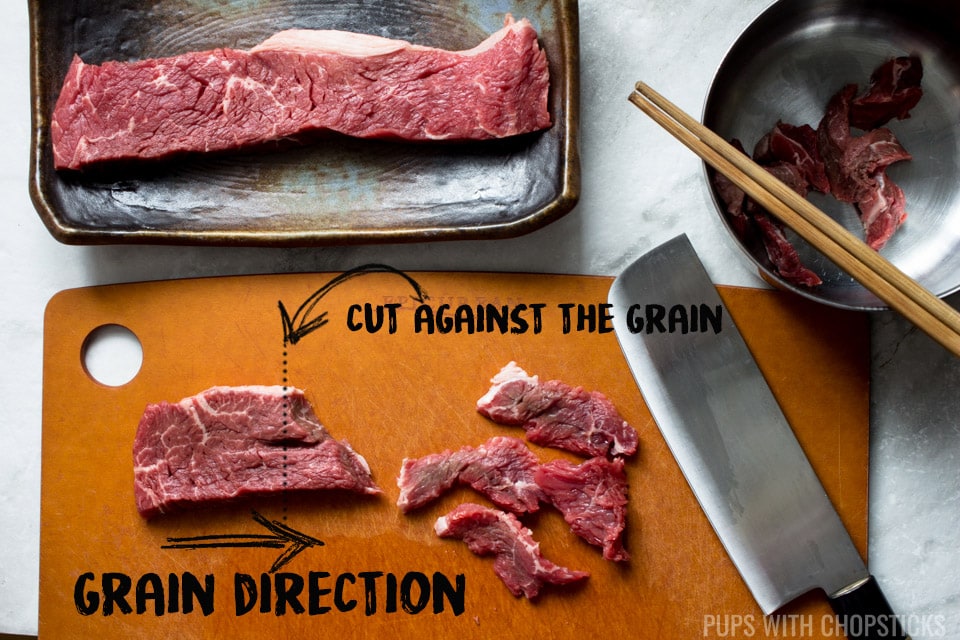
Preparing the Noodles for the Beef Chow Fun
This preparation step is pretty crucial to achieving evenly cooked noodles. When you are making this dish, you will be cooking it fast over high heat, and noodles that are not separated will stick together and break up into small broken pieces so it's definitely worth the effort to separate them before you start cooking.
To break up fresh ho fun, I use the microwave and nuke it for 1-2 minutes, in 30-second intervals.
At the 1-minute mark, check if the noodles are soft and easy to separate by hand.
Usually, the noodles on the outer edge of the plate will get soft first, move the soft noodles into the middle of the plate and nuke it for another 30-60 seconds until everything is soft.
Let the noodles cool before completely before stir-frying them.
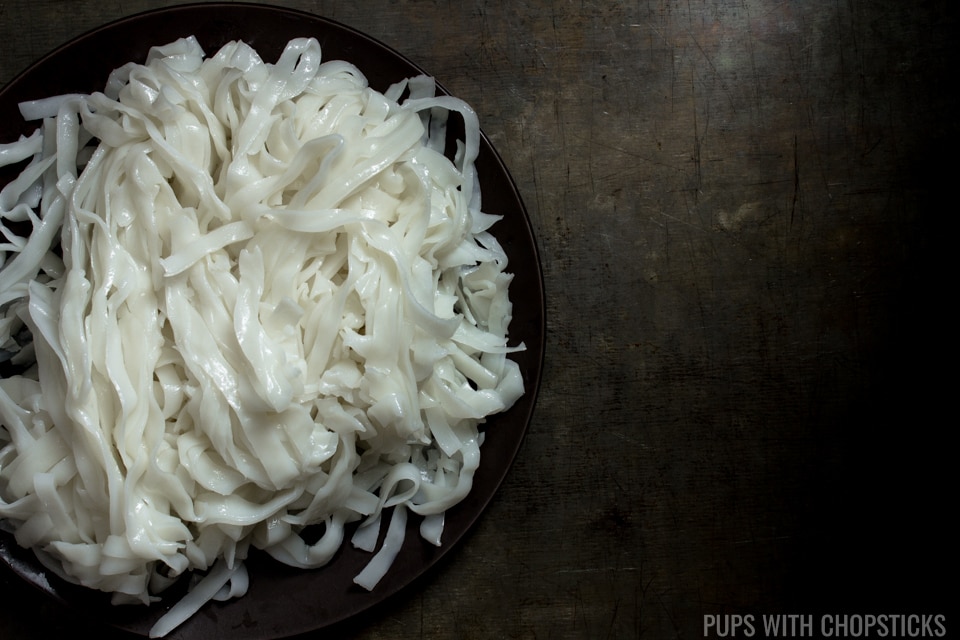
Non-Stick Pan or Well Seasoned Wok Works Best
If you have ever made stir-fried fresh ho fun noodles, you will know that they can easily stick to frying pans and half your noodles will end up burnt and stuck onto the bottom of the pan. The best way to avoid this is to make sure you use a non-stick frying pan or a very well-seasoned wok.
More Takeout Recipes You May Like
- Japchae (Stir-Fried Korean Glass Noodles)
- Cantonese Sweet and Sour Pork
- Singapore Noodles
- Crispy Cantonese Beef Chow Mein
- Sweet and Sticky Char Siu (Chinese BBQ Pork)
- Chilli Chicken
- Sweet and Sticky Crispy Beef
- Manchurian Chicken
- Saucy Beef Chow Ho Fun with Gravy
- Chinese Lemon Chicken
If you made this saucy beef and vegetable ho fun recipe, I want to see it! Follow Pups with Chopsticks on Instagram, snap a photo, and tag and hashtag it with @pupswithchopsticks and #pupswithchopsticks. I love to know what you are making!
If you want to be notified when I make new recipes, consider subscribing to my newsletter (we don't spam) or follow along on Instagram, Facebook, and Pinterest for all of my latest recipes!
Recipe Card
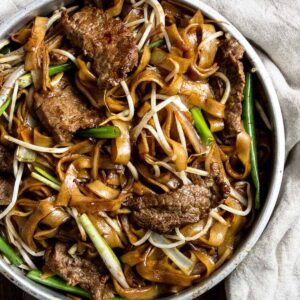
Beef Chow Fun (干炒牛河)
Joyce's Recipe Notes
- Try to use chopsticks instead of a spatula to toss and push the food around in the pan. Chopsticks are a bit more gentle and will help with keeping the noodles intact and not breaking it up into small pieces.
- A non-stick pan or well-seasoned wok is important for this recipe
- If you are having a hard time cutting thin slices of beef, stick the beef in the freezer for 30-40 minutes, and then try again. The firmness from it being frozen will make it easier to cut.
- If you are using dried rice noodles, make sure you are buying the wide ones that are ½ inch wide. They may be labeled as 'banh pho' as well.
- If you cannot find dark soy sauce, you can use regular soy sauce instead. The dark soy is what gives these noodles their dark signature color.
- This recipe has been tested with 750g (approx. 1.5 lbs) of rice noodles. If you use any less noodles than that, the recipe will be very salty. So scale the sauce based on how the amount of noodles you are using. Also, keep in mind, the more bean sprouts you put in this dish, the less salty it will be as well.
Ingredients
- 300 g flank steak (or any type of steak, cut thinly against the grain)
- 2-3 stalks green onion
- ⅓ white onion
- 750 g fresh sa ho fun noodles (1 package)
- 2 handfuls bean sprouts (approx. 1 ½ cups)
Beef Marinade
- 1 tablespoon soy sauce
- ½ teaspoon dark soy
- ½ tablespoon shaoxing cooking wine (or dry sherry)
- 2 tablespoons water
- ¼ teaspoon sesame oil (optional)
- ½ teaspoon cornstarch (optional)
Sauce
- 5 tablespoons light soy sauce (low sodium)
- 2 tablespoons dark soy sauce (optional, for color)
- 1 teaspoon sugar
Instructions
Preparation
- Wash the bean sprouts and set aside
- Cut ⅓ of a white onion into slices and set aside
- Wash the green onions and cut off the root ends. Cut the green onions into 2-inch segments. For the thicker parts of the green onions (the white parts) cut those in half lengthwise as well so they are easier to cook and not chunky. Set aside
- Slice the beef against the grain, and place it in a bowl with the marinating sauce. Mix well and set aside to marinate for 15 minutes.
Prepare and Soften the Noodles
- Place the fresh noodles on a plate and microwave it for 1-2 minutes in 30-40 second intervals. At the 1 minute mark, try to loosen up the noodles with your hands. The noodles on the outer edge of the plate usually will soften up first. Loosen the soft ones first, and then put them in the middle of the plate so the non-softened ones can be on the outer edge of the plate to have a chance to get soft.
- Once the noodles are a little soft and separated, set them aside to cool completely before stir-frying.
- (If You Are Using Dried Rice Noodles) Soak the dried wide rice noodles in hot water for 6-8 minutes until they are pliable and can be easily bent, then drain the water and set it aside.
Making the Sauce
- In a small bowl, combine all the sauce ingredients and set aside.(If You Are Using Dried Rice Noodles) - Add ¼ cup of water to the sauce mix.
Putting It Together
- Set the stove to high heat and add a bit of oil to a non-stick frying pan or well-seasoned wok.
- Once the pan is hot, add in the marinated beef and cook it for about 1-2 minute (No more than 2 minutes, you want the beef to be medium rare). Remove the beef from the pan and set aside for later
- Clean out the frying pan/wok and add in a bit of oil. Once the oil is hot add in the white onion and cook for about 1 minute.
- Then add in the noodles and the sauce mix at the same time and stir the noodles with the sauce. Use the sauce to soften up the noodles more, and keep moving the noodles around so that it doesn't stick to the pan. Cook it for about 1-2 minutes or until it looks soft.
- Throw in the bean sprouts and green onions and the cooked beef and quickly toss it into the noodles and turn off the heat.
- Continue to toss everything together and let the bean sprouts and green onions cook with the residual heat from the pan
- Remove from pan and enjoy! 🙂
Nutrition
*Nutritional information is calculated using online tools and is an estimate*
Disclaimer: We are a participant in the Amazon Services LLC Associates Program, an affiliate advertising program designed to provide a means for us to earn fees by linking to Amazon.com and affiliated sites, while I appreciate the support - I would prefer you buy your items locally if possible to support your local shops (and chances are they are cheaper locally as well!)

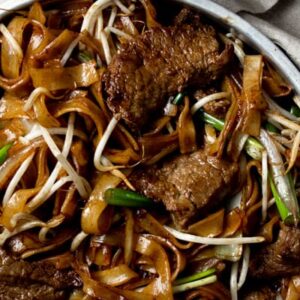
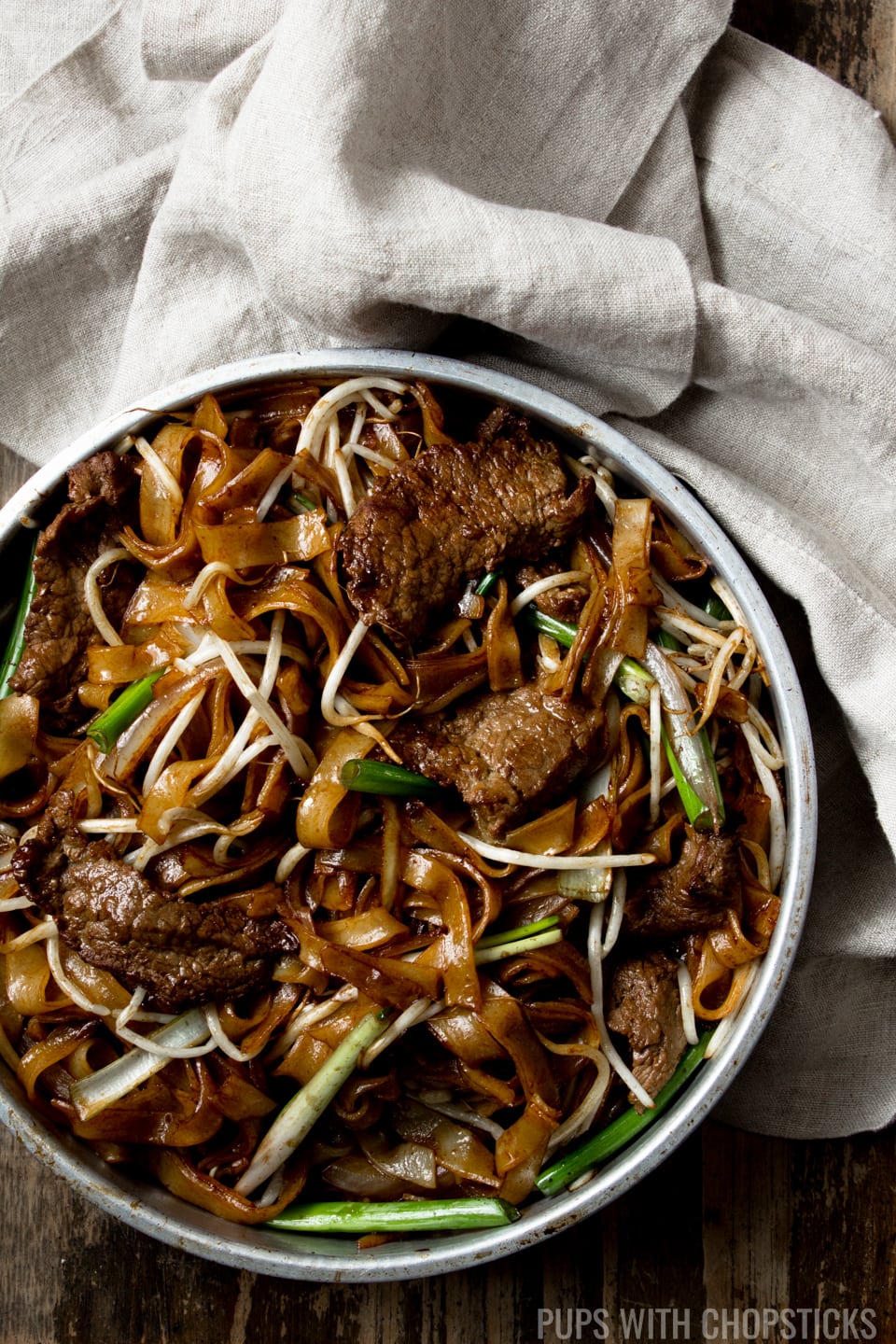
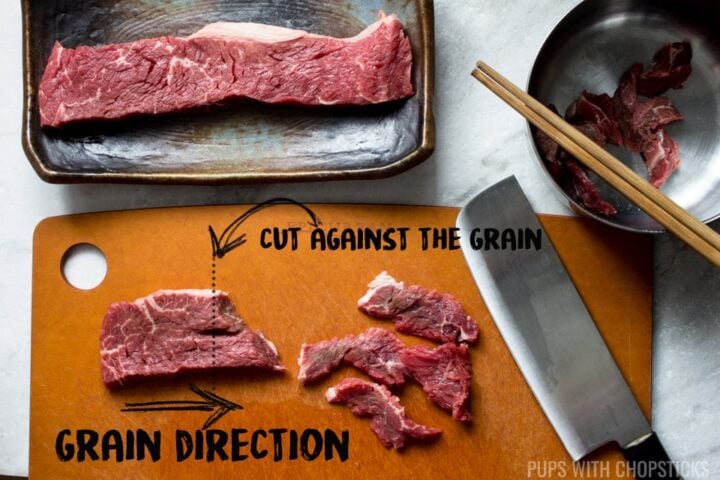
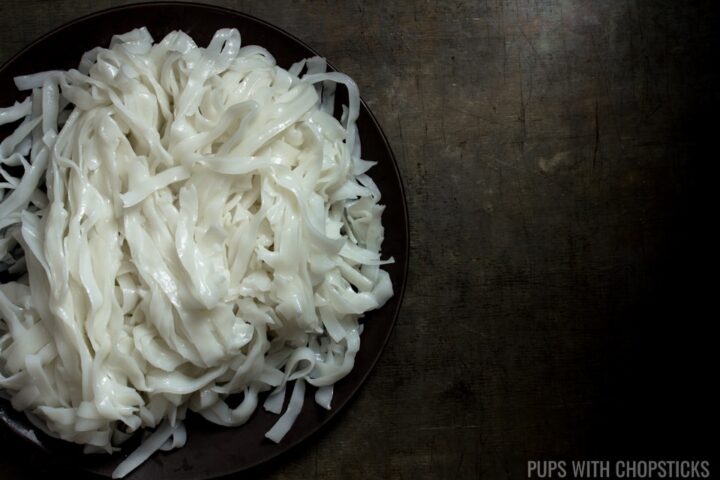
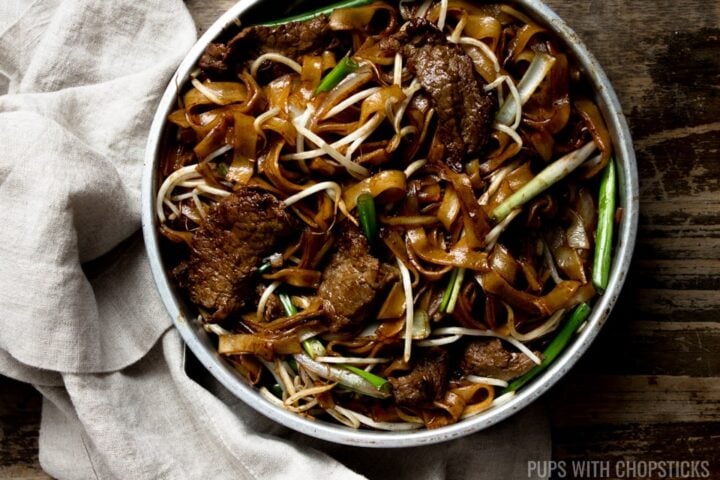
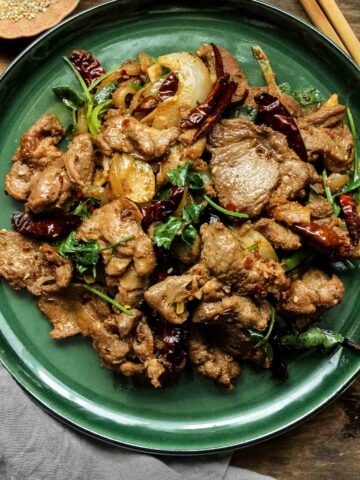

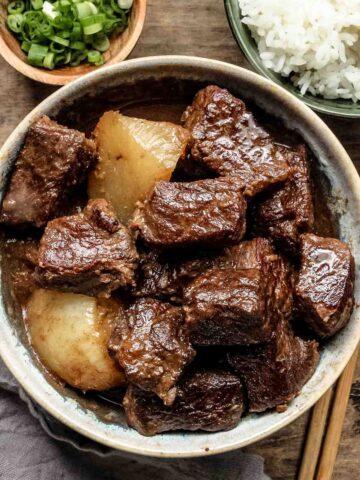

Emily says
Love this recipe. I cooked it with variations: used pork instead of beef, and Chinese Yu tsai because those were the ingredients I had at hand. Great kudos from the family for this dish. They loved the sauce in your recipe. This was my first success in cooking this dish. I would send you a picture of the finished dishes but unfortunately, couldn't post a picture as an attachment. Looking forward to trying your other recipes.
Joyce says
Hi Emily!
Mmmmm what a good idea adding Chinese Yu Tsai! I definitely need to do this in the future!
I'm super happy your family liked it! Give your family big hugs from me! 🙂
Caitlin says
Hi Joyce! Looking forward to trying this recipe, but I'm having trouble finding fresh noodles-- have you tried this with dried noodles yet, and are there any tips you could spare?
Joyce says
Hi Caitlin!
I have tried using the dried rice noodles but I only tried it once and have not documented my results since I felt like it needed a bit more testing. 🙂
Here is what I did do and what I found so far.
- Make sure you soak the dried noodles in hot water before you use it. Once the noodles are pliable and bendy, you are good to use it in the stir fry.
- I usually don't like to recommend boiling the dried noodles ahead of time because I find that it makes the noodles very mushy especially for stir-frying, hence I always suggest soaking it in very hot water for at least 20 minutes.
- The noodles won't be as soft as fresh noodles and when I cooked it following the recipe I have posted, I found that it absorbed all the soy sauce. Normally I would think that would be fine, but I noticed that the noodles were a lot drier and less flavorful because all the sauce got absorbed by the noodles, so I felt like as a whole, the recipe was missing a bit of flavor. To address this, I would do more testing by either adding more water to the sauce to compensate for the noodles absorbing the sauce to soften up, or I would increase the sauce by 25%-50% (not sure exactly how much yet. 🙂 )
I hope my notes help! 🙂 Now that you have me thinking about this again, I'm craving this again heehee! So I think I might try to make this soon with dry noodle again and document it properly for the actual recipe! Stay tuned!
and Happy New Year! 🙂
Maggie says
Tasted Great! Thank you for the detailed instructions 🙂
Joyce says
Hi Maggie!
I am so happy you liked this! I am always happy to help and I'm happy the instructions were clear! 😀
hermsoven says
Made this recipe once with beef and once with shrimp. Very tasty both ways.
However, I reduced the sauce from 5 to 3 tablespoons since I find that large quantities of soy sauce tends to make every ingredient taste like soy sauce and adds enough sodium for an army.
I use my hottest gas burner to heat the oil to almost smoking. I keep adjusting the flame to high after each ingredient is added. Maybe not wok hei level but really good anyway.
My Cantonese wife and I really enjoyed this version over all the other versions I’ve cooked. We always use fresh ho fun. I stack the 2 noodles and cut them crosswise into 1 inch segments. They separate nicely before the stir fry begins.
Not sure, but I think a little oyster sauce would benefit the flavor.
Thanks for posting your recipe.
Herman
Joyce says
Hi Herman!
I am so happy you liked this and that you made it your own by tweaking the sodium! 🙂 I actually think you are right, I find a little oyster sauce always adds a bit of extra umami and gives dishes a wonderful boost!
I am always happy to share recipes and yums!
JAMES POTOCZEK says
Looks tempting.
Joyce says
Thanks James! 🙂
Steven A Spence says
Boy I wish I saw your recipe first! This is one of my favorite Chinese dishes so I decided to give it a go by using a different recipe and I suffered the pains of the tightly packed fresh noodles as you had warned about. This recipe also had me cooking the noodles before the meat and my wife (who I met in Xiamen and married her here in Boise) told me this was all wrong, also too much meat to noodles (almost 1:1). I just told her about your recipe and she said this must be from a Chinese person, this is the correct way. Anyway I will making your recipe for our next Chinese church potluck lunch in 2 weeks and will use dry noodles instead (we have 4 or 5 Asian markets here so a pretty good selection). I’ll let you know how it turns out!
Joyce says
Hi Steven,
This is one of my favorite dish as well! 🙂 So I completely understand what you mean, I have had many failed attempts with the tightly fresh noodles as well 🙂 With the fresh noodles, the only ones that worked for me were the ones that are packaged in a styrofoam plate and plastic wrapped, you just have to warm them up in the microwave to soften them before separating them. The fresh noodles packaged into plastic bag and bundled up into a big chunk are very difficult to work with for stir fries so definitely avoid those.
If you are using the dried noodles (which I find are the easiest ones to work with) make sure you soak them in warm water until they are soft before you stir fry it. I also find that the dry noodles need a bit more liquid when you are stir frying to reconstitute it, so you may need to add a few tablespoons of water to it while it is stir frying before adding the sauce.
Hope this helps and hope it turns out for your church potluck! 🙂 Let me know if you have any questions as well!
...and yes your wife is right! I am Chinese! 😀
Josie says
I love this Beef Chow Fun. Never get fed up. Easy to cook. I personally add extra more bean sprouts to bring out better eating texture in the mouth. Thank you.
Joyce says
I never get tired of this noodle either! Adding more bean sprouts is definitely an amazing way to make it a bit healthier too! 🙂